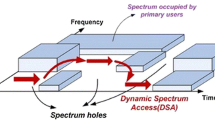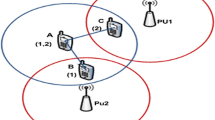Abstract
With increasing demand of new wireless applications and increasing number of wireless user’s, problem of spectrum scarcity arises. In this context, cognitive radio supports dynamic spectrum access to address spectrum scarcity problem. Cognitive radio defined the cognitive radio nodes by their ability to intelligently adapt the environment to achieve specific objectives through advanced techniques. The variance of channel availability for cognitive radio nodes degrades connectivity and robustness of this type of network; in this case the use of clustering is an effective approach to meet this challenge. Indeed, the geographical areas are homogeneous in terms of type of radio spectrum, radio resources are better allocated by grouping cognitive radio nodes per cluster. Clustering is interesting to effectively manage the spectrum or routing in cognitive radio ad hoc networks. In this paper, we aim to improve connectivity and cooperativeness of cognitive radio nodes based on the improvement of the k-means algorithm. Our proposed algorithm is applied in cognitive radio ad hoc networks. The obtained results in terms of exchange messages and execution time show the feasibility of our algorithm to form clusters in order to improve connectivity and cooperativeness of cognitive radio nodes in the context of cognitive radio ad hoc networks.











Similar content being viewed by others
References
Mitola, J, I. I. I., Maguire, J. R., & Gerald, Q. (1999). Cognitive radio: Making software radios more personal. IEEE Personal Communications, 6(4), 13–18.
Kasbekar, G. S., & Sarkar, S. (2010). Spectrum auction framework for access allocation in cognitive radio networks. IEEE/ACM Transactions on Networking (TON), 18(6), 1841–1854.
Akyildiz, I. F., Lee, W. Y., & Chowdhury, K. R. (2009). CRAHNs: Cognitive radio ad hoc networks. Ad Hoc Networks, 7(5), 810–836.
Grabusts, P., et al. (2011). The choice of metrics for clustering algorithms. In Proceedings of the 8th International Scientific and Practical Conference.
Kaufman, L., & Rousseeuw, P. J. (2009). Finding groups in data: An introduction to cluster analysis. New York: Wiley.
Xu, R., & Wunsch, D. (2008). Clustering. New York: Wiley.
MacQueen, J. (1967). Some methods for classification and analysis of multivariate observations. In Proceedings of the Fifth Berkeley Symposium on Mathematical Statistics and Probability. (Vol. 1, pp. 281–297).
Elmasri, R. (2008). Fundamentals of database systems. New Delhi: Pearson Education India.
Nazeer, K. A. A., & Sebastian, M. P. (2009). Improving the accuracy and efficiency of the k-means clustering algorithm. In Proceedings of the World Congress on Engineering (pp. 1–3).
Davies, D. L., & Bouldin, D. W. (1979). A cluster separation measure. IEEE Transactions on Pattern Analysis and Machine Intelligence, 1(2), 224–227.
Yedla, M., Pathakota, S. R., & Srinivasa, T. M. (2010). Enhancing K-means clustering algorithm with improved initial center. International Journal of Computer Science and Information Technologies, 1(2), 121–125.
Zhang, C., & Xia, S. (2009). K-means clustering algorithm with improved initial center. In Second International Workshop on Knowledge Discovery and Data Mining, 2009. WKDD 2009 (pp. 790–792).
Yao, H., Duan, Q., Li, D., et al. (2013). An improved K-means clustering algorithm for fish image segmentation. Mathematical and Computer Modelling, 58(3), 790–798.
Arai, K., & Barakbah, A. R. (2007). Hierarchical K-means: An algorithm for centroids initialization for K-means. Reports of the Faculty of Science and Engineering, 36(1), 25–31.
Sathiya, G., & Kavitha, P. (2014). An efficient enhanced K-means approach with improved initial cluster centers. Middle-East Journal of Scientific Research, 20(1), 100–107.
Merz, P. (2003). An iterated local search approach for minimum sum-of-squares clustering. In Advances in Intelligent Data Analysis V. (Vol. 2810, pp. 286–296). Springer Berlin Heidelberg.
Fahim, A. M., Salem, A. M., Torkey, F. A., et al. (2006). An efficient enhanced k-means clustering algorithm. Journal of Zhejiang University Science A, 7(10), 1626–1633.
Zhang, J. Z., Yao, F. Q., & Zhao, H. S. (2012). Distributed clustering in cognitive radio ad hoc networks using soft-constraint affinity propagation. Radioengineering, 21(3), 785–794.
Zhang, H., Zhang, Z., Dai, H., et al. (2011). Distributed spectrum-aware clustering in cognitive radio sensor networks. In Global Telecommunications Conference (GLOBECOM 2011), 2011 IEEE (pp. 1–6).
Asterjadhi, A., Baldo, N., & Zorzi, M. (2010). A cluster formation protocol for cognitive radio ad hoc networks. In 2010 European Wireless Conference (EW) (pp 955–961).
Li, D., & Gross, J. (2011). Robust clustering of ad-hoc cognitive radio networks under opportunistic spectrum access. In 2011 IEEE International Conference on Communications (ICC) (pp. 1–6).
Mansoor, U., & Shahid, M. K. (2014). Cluster based energy efficient sensing for cognitive radio sensor networks. International Journal of Computer Applications, 88(7), 14–19.
Ozger, M., & Akan, O. B. (2013). Event-driven spectrum-aware clustering in cognitive radio sensor networks. In INFOCOM, 2013 Proceedings IEEE (pp. 1483–1491).
Fipa, A. C. L. (2002) Fipa acl message structure specification. Foundation for Intelligent Physical Agents. http://www.fipa.org/specs/fipa00061/SC00061G.html 30 June 2004.
JAVA Agent Development Framework. Open source platform for peer-to-peer agent based applications. http://jade.tilab.com/.
Foundation for Intelligent Physical Agents. Specifications. 1997. http://www.fipa.org.
Benidris, F. Z., Benmammar, B., & Krief, F. (2015). A novel approach to spectrum management in cognitive radio networks using agent coalition formation. International Journal of Wireless and Mobile Computing, 9(1), 27–35.
Author information
Authors and Affiliations
Corresponding author
Rights and permissions
About this article
Cite this article
Benmammar, B., Taleb, M.H. & Krief, F. Diffusing-CRN k-means: an improved k-means clustering algorithm applied in cognitive radio ad hoc networks. Wireless Netw 23, 1849–1861 (2017). https://doi.org/10.1007/s11276-016-1257-4
Published:
Issue Date:
DOI: https://doi.org/10.1007/s11276-016-1257-4




